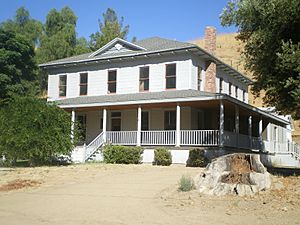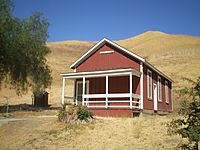Mentryville, California facts for kids
Quick facts for kids
Mentryville
|
|
|---|---|

C.A. Mentry House in 2008
|
|
| Country | United States |
| State | California |
| County | Los Angeles |
| Elevation | 1,609 ft (490 m) |
| Time zone | UTC-8 (PST) |
| • Summer (DST) | UTC-7 (PDT) |
| Area code(s) | 661 |
| Website | www.scvhistory.com/mentryville/ |
| Reference #: | 516-2 |
Mentryville was an old town in Los Angeles County, California, USA. It was built in the Santa Susana Mountains because of newly found oil reserves. The town was started in the 1870s by Charles Alexander Mentry. The very first oil was found there on September 26, 1876.
Today, Mentryville is part of Stevenson Ranch. You can find it at the end of Pico Canyon Road, about four miles west of the I-5 freeway in Santa Clarita.
Contents
History of Mentryville
Charles Alexander Mentry was born in France in 1847. He moved to California and started working with oil wells in the 1870s. In 1875, he joined with other people to work on the Pico Oil claim. Mentry was in charge of the oil field from 1876 until he died in 1900.
California's First Oil Well
A short distance from Mentryville, a well called "Pico Number 4" was drilled. This was California's first oil well that made money. It was also the longest-running oil well ever, finally closing in 1990.
The Pico Canyon oil field became the richest in California at that time. Because of this, Mentryville grew into a busy "boomtown" from 1876 to 1900.
Life in the Oil Town
The town was named after Charles Alexander Mentry, who lived there until he passed away. He built a large 13-room house that is still standing today.
In 1900, a newspaper described Mentryville as a great place to live. It had homes, a schoolhouse, a social hall, a bakery, and places for workers to stay. There was even a tennis court with gas lights and croquet fields. The main road was paved with local asphalt.
Interestingly, Mentryville did not have a bar. Charles Mentry wanted the town to be a good place for families. He reportedly did not allow drinking or bad language. When Mentry died, almost everyone in the town went to his funeral in Los Angeles.
Why Mentryville Became a Ghost Town
Mentryville eventually became empty. This happened partly because less oil was found over time. Also, the oil industry changed. By the 1930s, most people left Mentryville. Many even took their houses apart and moved the pieces with them.
By 1962, Mentryville was a true ghost town. Only a family who took care of the property lived in Mentry's old house. A visitor at that time saw rusted oil equipment and old derricks (oil drilling towers) falling apart. The cemetery was overgrown with weeds.
Saving Mentryville
The last person to take care of Mentryville was Francis "Frenchy" Lagasse. He moved into the Mentry mansion with his family in 1966. The owner of the property, Standard Oil of California, wanted to tear down the old buildings. But Lagasse convinced them to let him restore the town instead.
With help from the Santa Clarita Historical Society, Lagasse started giving tours of Mentryville. After an earthquake in 1994 damaged the house, Lagasse had to leave. In 1995, Chevron (which owned Standard Oil) gave the Mentryville site and 800 acres of land to the Santa Monica Mountains Conservancy.
A group called the Friends of Mentryville was formed to help. They worked to fix the buildings and open the old town as a historic park. Today, you can take tours led by guides.
The site is now officially recognized as California Historical Landmark #516-2.
Mentryville has faced challenges. A fire almost destroyed the historic buildings in 2003. A storm in 2004 washed out the parking lot and flooded the old buildings.
Mentryville in Movies and TV
Mentryville and Pico Canyon are popular places for filming movies and TV shows.
- Movies like Steven Spielberg's "The Color Purple" and "Walking Tall Part 2" were filmed there.
- TV shows such as "The X-Files", "The A-Team", "Murder, She Wrote", and "Highway to Heaven" also used the location.
- Mentryville was also featured in an episode of "Ghost Adventures" (Season 26, Episode 5).
California Historical Landmark Markers
There are two important historical markers at the site:
- Marker No. 516-2 MENTRYVILLE: This marker tells us that the town was named after Charles Alexander Mentry. He drilled California's first successful oil well in 1876. His restored home, barn, and the Felton School are still there. This is also where the Star Oil Company, which later became part of Standard Oil of California, began.
- Marker No. 516 WELL, CSO 4 (PICO 4): This marker is for Pico No. 4, California's first oil well that produced oil for sale. It was started in 1876 and produced 30 barrels of oil a day. Later, it was deepened and produced 150 barrels a day. This well was still producing oil 77 years later in 1953! Its success led to the creation of the Pacific Coast Oil Company (another company that became part of Standard Oil) and the building of California's first oil refinery nearby. This well was very important for the start of California's oil industry.





